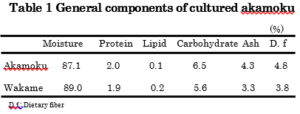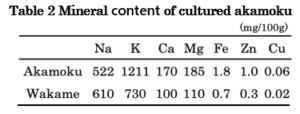Publication Information
ISSN 2691-8803
Frequency: Continuous
Format: PDF and HTML
Versions: Online (Open Access)
Year first Published: 2019
Language: English
| Journal Menu |
| Editorial Board |
| Reviewer Board |
| Articles |
| Open Access |
| Special Issue Proposals |
| Guidelines for Authors |
| Guidelines for Editors |
| Guidelines for Reviewers |
| Membership |
| Fee and Guidelines |
 |
Elucidation of Food Functionality of Farmed Sargassum Horneri (Akamoku) and Its Role as a Global Warming Countermeasure
Akiko YAMADA TANIGUCHI1*, Machiko KAZAMI1, Haruko NOGUCHI1
1Department of Agricultural Innovation for Sustainable Society, Faculty of Agriculture, Tokyo University of Agriculture, Japan
Received Date: February 27, 2023; Accepted Date: March 09, 2023; Published Date: April 16, 2023;
*Corresponding author: Akiko YAMADA TANIGUCHI, Department of Agricultural Innovation for Sustainable Society, Faculty of Agriculture, Tokyo University of Agriculture, Japan. Email: akiko@nodai.ac.jp
Citation: TANIGUCHI A Y, Machiko KAZAMI M, NOGUCHI H (2023) Elucidation of Food Functionality of Farmed Sargassum Horneri (Akamoku) And Its Role as A Global Warming Countermeasure. Adv Agri Horti and Ento: AAHE-181.
DOI: 10.37722/AAHAE.2022402
Abstract
In this study, we considered the “blue carbon” credentials of the seaweed Sargassum horneri (or “akamoku” in Japanese), with respect to its ability to absorb carbon dioxide and so act as a measure against global warming, and considered its use as a functional food. We measured the general components, fiber, minerals, and polyphenol levels of akamoku (S. horneri ) cultured on ropes submerged in the sea off the coast of Minamiboso City, Chiba Prefecture, Japan. Results showed higher levels of protein, carbohydrates, ash, and dietary fiber than wakame (a well-known edible seaweed). Levels of potassium, calcium, magnesium, iron (×2.5), zinc (×3.3), and copper (×3) were also higher than in wakame. The level of polyphenols in the cultured akamoku was -2.6 times higher than that in wakame. Given these results, we believe akamoku has the potential to be a superior functional food with antioxidant activity, and at the same time, its culture would act as a countermeasure to global warming.
Keywords: Antioxidant Activity; Blue Carbon; Mineral Content; Polyphenol Content
Introduction
This study, which was conducted in Minamiboso City, Chiba Prefecture, focused on the potential of cultivated Sargassum horneri (a brown Sargassum alga, known as “akamoku” in Japanese) to fulfill two roles, as a food and as a “blue carbon” agent useful in absorbing carbon dioxide from the atmosphere. During growth, akamoku absorbs and fixes the greenhouse gas carbon dioxide and also takes up nitrogen and phosphorus (both of which cause red tides); hence, it is considered useful for environmental purification. Removal of carbon dioxide is useful as global warming countermeasure, and this species is also thought to play a role as a seaweed bed for spawning fish and shellfish and to provide a beneficial environment for growing larvae and fry(Umezaki, I., 1984).
Akamoku grows to approximately 10 m in length and becomes reddish brown as it ages. In Japan, it is widely distributed from Hokkaido (except the northernmost part) to Kyushu. While brownish in the raw state, it turns bright green when boiled and has a sticky texture and is considered to be seaweed with high utility value as a food. In recent years, akamoku has been gaining in popularity, attracting attention as a functional food and for its pleasant texture. As it has considerable commercial value, it is expected that the aquaculture of akamoku will increase, which will be beneficial for the global environment and lead to regional revitalization. As there are few research reports on akamoku (compared with kelp, wakame (Undaria pinnatifida), and mozuku (Cladosiphon okamuranus), our aim in this study was to analyze and report on akamoku as a functional food.
Methods
Test material
The akamoku was cultivated (farmed) at Chikura Fishing Port in Minamiboso City, Chiba Prefecture, and was harvested in February 2020. For aquaculture, akamoku seedlings -5 cm in length were inserted into a rope, which was then submerged and tethered in the sea off the coast (Figure 1).

Figure 1: Akamoku seedlings.
Measurement of general components
Measurements of water, protein, fat, ash, and carbohydrate were performed according to the methods in the Standard Tables of Food Composition in Japan. Moisture was measured by the normal pressure heating and drying method (Akio. M et al.,1999). Protein was measured using the Kjeldahl decomposition method (Akiko, T., 2014), fat was measured using the Soxhlet extraction method (Akio. M et al.,1999), and ash was measured using the direct ashing method (Akio. M et al.,1999). Carbohydrate levels were calculated using the deduction method (Akiko, T., 2014).
Measurement of the dietary fiber content
The modified dietary fiber method (Akio. M et al.,1999) was used to measure dietary fiber. Briefly, 1 g of crushed akamoku was sequentially treated with heat-resistant α-amylase, protease, and amyloglucosidase according to the Proski method (Akio. M et al.,1999), and then, the filtrate and the residue were separated, precipitated and washed with ethanol and acetone, and dried and weighed.
Measurement of mineral content
Mineral content was measured using atomic absorbance analysis 9). A sample was incinerated and then dissolved in a 0.1 M hydrochloric acid solution. A Shimadzu AA-6300 atomic absorption spectrophotometer was used, and sodium (589.0 nm), potassium (766.5 nm), calcium (422.7 nm), magnesium (285.2 nm), iron (248.3 nm), zinc (213.9 nm), and copper (324.8 nm) levels were measured.
Measurement of polyphenol content
Polyphenol levels were measured using the Folin–Ciocalteu method (Tojiro, T., 2000). A water extract of the sample (200 μl) was added to 3.2 ml of water, 200 μl of Folin–Ciocalteu reagent was added, and the mixture was stirred. Then, 400 μl of a saturated aqueous sodium carbonate solution was added, and the mixture was left for 10 min before the absorbance was measured at 700 nm. The amount of polyphenol was calculated from a calibration curve constructed using gallic acid.
Color tone measurement
After immersing akamoku in a boiling water bath for 1 min, the color tone was measured with a color difference meter (CM-600d, Konica Minolta Co., Ltd.) according to the CIELAB/L*a*b* system. We also subjected wakame to the same treatment for comparison.
Results and Discussion
General components and dietary fiber
The water content of the cultured akamoku was 87.1% (Table 1), approximately the same as that of seaweed in general and about 2% lower than wakame (Akio, K.,2021). The cultured akamoku had higher levels of protein, carbohydrates, and ash when compared with wakame, and a high level of dietary fiber. The main types of dietary fiber in brown algae are cellulose (a cell wall polysaccharide), laminarin (a storage polysaccharide), and alginic acid and fucoidan (mucilage polysaccharides) (Kaori, M., 2011). The fucoidan-like substance found in akamoku is known to have antitumor activity (Shozo, N.et al ., 1984 ).
Ash content was particularly high, 1% higher than that of wakame, and mineral levels were also high.
The lipid levels in the cultured akamoku were slightly lower than in wakame but were similar to those in other seaweeds. Among the general components, lipids were the lowest fraction, and at levels similar to seagrasses (Mabeau, S., et al.,1993).
Akamoku was confirmed as having high levels of ash and dietary fiber, and high food functionality.
 Mineral content
Mineral content
Table 2 shows the mineral levels in the cultured akamoku. The akamoku was rich in minerals and functionality; with six out of the seven measured minerals at higher levels than wakame (only sodium levels were lower). Reportedly, naturally grown akamoku is rich in potassium, calcium, and magnesium (Yoko, A., 2005); this study confirms that the same applies to cultured akamoku. In comparison with wakame, akamoku contained more iron (×2.5), more zinc (×3.3), and more copper (×3).
It is known that the Japanese diet tends to be deficient in minerals, especially calcium, magnesium, and iron. Our results indicate that akamoku could contribute to addressing this problem if eaten as part of the diet.

Polyphenol level
The level of polyphenols in the cultured akamoku was high (80.1 mg/100 g), approximately 2.6 times higher than that of wakame (31.1 mg/100 g) (Shinichiro, O. et al., 2014). Wakame is regarded as having a high level of polyphenols, a known characteristic of this seaweed’s functionality. Considering that this study shows that akamoku contains higher levels of polyphenols, expectedly, akamoku will exhibit antioxidant functionality(Table 3).
Color tone
Comparing color tone results for boiled akamoku and wakame, we found akamoku to be lighter (L*, 52.10 vs. 48.88), greener (a*, −28.14 vs. −14.98), and yellower (b*, 47.2 vs. 20.11), confirming the perceived brighter yellowish-green of the akamoku (Table 4). This color is thought to derive from chlorophyll and fucoxanthin (Ebina, H., 2009), and we suggest that the color of akamoku is related to the level of polyphenols.

Conclusions
This study confirms akamoku (S. horneri) to be a rich source of protein, carbohydrates, and dietary fiber. It also has high ash content, reflecting high levels of potassium, calcium, magnesium, iron, zinc, and copper. Its high levels of polyphenols would confer antioxidant properties. All these factors were generally superior to those of wakame, suggesting that akamoku would be a superior functional food. As seaweeds play an important “blue carbon” role, farming akamoku would be of benefit in efforts to mitigate global warming. The aquaculture in this study was conducted on a small scale, but in the future, we plan to examine culturing akamoku on a large scale and to consider potential beneficial effects on global warming.
Acknowledgment: We would like to express our sincere gratitude to Dr. Masao Ohno and Dr. Kenji Hotta for their guidance in this research.
References
- Akiko, T (2014) Textbook on food chemistry experiments learned from the basics, outline of experiments on III-2 proteins and amino acids, 10. Quantification by Kjeldahl method, Kenpakusha, 50-53.
- Akiko, T (2014) Textbooks on food chemistry experiments learned from the basics, Ⅲ-4 Outline of experiments on carbohydrates and sugars, 20. Calculation by deduction method, Kenpakusha, 78-79.
- M., and Tatsuyuki. S (1999) New food analysis handbook, 2.1.1.2. atmospheric pressure heating and drying method, Tokyo, Kenpakusha, 15-23.
- M., and Tatsuyuki. S (1999) New food analysis handbook, 2.3.1.1. Lipids, Tokyo, Kenpakusha, 57-102.
- M., Tatsuyuki. S (1999) New food analysis handbook, 2.5.1.1. Direct ashing method, Tokyo, Kenpakusha, 152-154.
- M., and Tatsuyuki. S (1999) New food analysis handbook, 2.4.6.4. Prosky (AOAC-AACC) Method, Tokyo, Kenpakusha, 133-135.
- M., and Tatsuyuki. S (1999) New food analysis handbook, 2.1.6.5. Modified Prosky method (AOAC method for separating water-soluble and insoluble dietary fiber, Tokyo, Kenpakusha, 135-136.
- M., and Tatsuyuki. S (1999) New food analysis handbook, 2.5.5. Quantification method of minerals, Tokyo, Kenpakusha, 164-193.
- Akio, K. (2021) Eighth edition food ingredients table 2021. kagawa nutrition university publishing department. Algae,138.
- Ebina, H (2009) A study on the properties of freeze-dried Akamoku and its thickening using the dried product. Niigata Prefectural Fisheries and Ocean Research Institute Report, No.2, 63-68.
- Kaori, M. (2011) Characteristics of seaweed akamoku and food use. Hiroshima Institute of Technology Bulletin Research, 45, 263-270.
- Mabeau, S.(1993) Seaweed in food products: biochemical and nutritional aspects, Fleurence. J. Trends in Food Science Technology, No.4, 103-107.
- Shozo, N., Fumiki, A., Hiroyuki, K., Keizo, K., Tadahide, H., Isamu, U (1984) Study on the antitumor effect of seaweed components 2nd report, Sargassum horneri. Journal of Japan Society of Chemotherapy, No.24, 443-447.
- Shinichiro, O., Yoji, K (2014) Seasonal changes in sugars, amino acids and polyphenols contained in Ecklonia stolonii. Japan Society for Food Science and Technology,61, 268-277.
- Tojiro, T. (2000) Food function research method, 4-1 polyphenol analysis method, colorimetric quantification method, Tokyo, Korin, 318-322.
- Umezaki, I (1984) Ecological studies of Sargassum horneri (Turner) C. Agardh in Obama Bay, Japan Sea. Bull. Japan. Social Science Fish, No.50, 1193-1200.
- Yoko A, Munenobu O, Yumiko Y, Ken S (2005) Changes in minerals, free amino acids and fatty acids due to heating of Akamoku, Journal of the Japanese Cooking Society, No.38, 72-76.